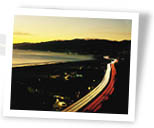

Southern California
Pacific Coast Highway (a.k.a. 101) in Southern California. Highway 101 from Santa Barbara south provides miles of picture perfect beach. The arid landscape is mixed with blankets of wildflowers and towering eucalyptus trees. Mornings often begin with fog and conclude with sunshine. Cafes and open air markets offer a cornucopia of treasures. The Spanish Mission influence and the power of the sea rival the opulence of Hollywood.
Time travel California style. The Pioneer Village and Kern County Museum in Bakersfield provides oodles of ways to connect with the past as well as the future. Situated on 16 acres, the complex has more than 50 historical buildings dating from 1865-1945. The grounds provide an enjoyable way for generations to share experiences in an interactive, educational, and historically rich setting. From the Lilliputian size town for kids to the story of oil, visitors are entertained with caring and purpose. Discovery: The Lori Brock Children’s Discovery Center is a treasure for the tiniest of guests. (3801 Chester Avenue, Bakersfield, 93301. 1(661) 852-5000 or kerncountymuseum.org)
Follow a roadrunner. At the California Living Museum (CALM) visitors will enjoy the antics of a resident roadrunner in the desert habitat. CALM is a zoo, botanical garden and natural history museum in one location that showcases living plants and animals native to California. They provide displays and information about native animals, plants, specimens, and artifacts. Respect for all living things is demonstrated through education, recreation, conservation, and research. (10500 Alfred Harrell Hwy. Bakersfield, 93306-9654. 1-800-872-CALM, 1(661) 872-CALM (2256) or www.calmzoo.org)
Search the heavens. The 1930s art deco Griffith Observatory is undergoing an extensive facelift planned for completion in 2005. Until then the Satellite location will provide the link to the skies. It features a public space with a modest display of astronomy exhibits, an innovative planetarium theater, a lecture/presentation/meeting area, and a telescope to view the moon and planets at night. They still host public star nights and a free public telescope is pointed toward the moon and planets each night that it is open. (Griffith Observatory Satellite, 4800 Western Heritage Way Los Angeles, 90027. 1(323) 664-1181 or www.griffithobservatory.org)
Sing with the cowboys. Discover the cultural nuances of the American West at The Autry Museum of Western Heritage also in Griffith Park. Through our wide-ranging exhibitions, collections, programs, and educational offerings, they connect the past to the present and showcase the history of the region west of the Mississippi River. Throughout the year they have a selection of workshops, classes, and activities for children. Discovery: Within the museum there is a Hands-on Family Discovery Gallery, where children and their families learn about history through games and exploration (4700 Western Heritage Way, Los Angeles, 90027-1462. 1(323) 667-2000 or theautry.org)
Hug a tree, pet a goat. The Los Angeles Zoo and Botanical Gardens is one of nine accredited botanical gardens in the country with an impressive collection of plants as well as animals. Located on 113 acres in the heart of Griffith Park it is home to species from around the globe. In addition to browsing the zoo independently there are several organized zoo adventures for families. Discover the wonders of wildlife as you learn about amazing animals, terrific habitats, and fantastic ways to survive. Discovery: The children’s zoo has an interactive living book series and docents provide many opportunities for animal encounters from holding birds of prey to grooming domestic farm animals. (5333 Zoo Drive, Los Angeles, 90027-1498. 1(323) 644-6400 or www.lazoo.org)
Get into a tar pit. One of the world’s most famous fossil sites is literally in the middle of Los Angeles. The Page Museum is located at the Rancho La Brea Tar Pits, contains displays and exhibitions of a diverse assemblage of extinct Ice Age plants and animals. Within the museum special viewing windows allow for visitors to watch ongoing work in the paleontology lab that services the famous “Pit 91” excavations. Outside the Museum, in Hancock Park, life-size replicas of several extinct mammals are featured. Each summer scientists return to continue work at “Pit 91,” where they are seeking more Ice Age fossils for study. Discovery: There is an observation Station in Hancock Park that is open free to the public Wednesday through Sunday. (5801 Wilshire Blvd. Los Angeles, 90036. 1(323) 934-PAGE (7243) or www.tarpits.org)
Ride over the zoo. Located in beautiful Balboa Park, the 100-acre San Diego Zoo cares for more than 4,000 individual animals representing 800 different species. It is recognized as one of the finest zoological parks in the entire world. In addition to seeing state-of-the-art bioclimatic habitats that place animals in familiar settings, visitors may get a birds eye view of wildlife from the Skyfari aerial tram or stroll tree shaded pathways and boardwalks. The variety of interesting programs and animal encounter is endless. Discovery: Families may take behind-the-scene tours, participate in mini wildlife workshops or make a visit at night. (2920 Zoo Drive, San Diego, 92101.1(619) 234-3153 or zoo.sandiegozoo.org)
Walk on the wild side. The San Diego Zoo has a sister site just 32 miles northeast of the Zoo near the city of Escondido. The Safari Park is 20 times larger than the Zoo and is a totally different experience. The 1,800-acre wildlife preserve provides visitors with fantastic views of exotic animal herds in terrain that is similar to habitats of Asia and Africa. The Park has more than 3,500 animals representing 260 species, and is also an accredited botanical garden. (15500 San Pasqual Valley Road, Escondido, 92027-7017. 1(760) 747-8702 or www.sdzsafaripark.org)
Visit the big one. Palomar Observatory, atop Palomar Mountain, is the location of the largest telescope in the United States. The Observatory is open to the public daily (except December 24 and 25) for a self-guided visit to the 200-inch telescope. The gallery at the 200-inch dome affords a view of the Hale Telescope. Because this observatory is a working research center night visits by the public are not possible. Discovery: One exception, The Reuben H. Fleet Science Center conducts a limited number of night-guided tours. (35899 Canfield Road Palomar Mountain. 92060-0200. 1(626) 395-4033 or www.astro.caltech.edu)
Touch science and technology. The Reuben H. Fleet Science Center is a blast for all ages. The exhibit galleries provide “hands-on,” “do touch” interactive exhibits that make unique self-guided learning experiences for all ages. The have cutting-edge virtual reality exhibits ideal for teens and young adults. They also have a special discovery area for ages two to six. Enjoy an IMAX evening or take a special tour to Palomar Observatory and see one of the largest and most famous telescopes in the world. Discovery: The private off site tours include the Observatory Museum, a close up look at the famous 200-inch telescope, an astronomy guest speaker and, weather permitting, a view through the biggest telescope used for naked-eye observing. (1875 El Prado, San Diego, 92101. 1(619) 238-1233 or www.rhfleet.org)
Become a raindrop. The Birch Aquarium at Scripps is an inspirational place. In addition to the dramatic coastal setting the facility has innovative exhibits and countless programs available to the public. The aquarium frames a central lobby. Three main interpretive areas include; The Hall of Fishes with more than 60 tanks; The Hall of Oceanography, perhaps the largest display on oceanographic sciences in the US; and an outdoor plaza with a demonstration tide pool and discovery station. See dive shows and speak with marine specialists. Watch leafy and weedy sea dragons, part of the “Secrets of the Seahorse” exhibition, touch tide-pool residents, watch the earthquake monitor in action. Discovery: Become a water drop for three minutes on Morphis the MovieRide that makes participants feel like a drop of water. (2300 Expedition Way, La Jolla, 92037. 1(858) 534-FISH or www.aquarium.ucsd.edu)
Content syndication services provided by TheFamilyTravelFiles.com
